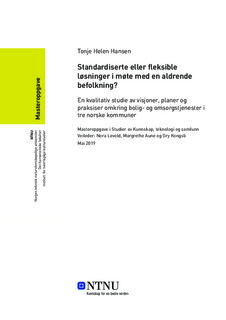| dc.contributor.advisor | Levold, Nora | |
| dc.contributor.advisor | Aune, Margrethe | |
| dc.contributor.advisor | Kongsli, Gry | |
| dc.contributor.author | Hansen, Tonje Helen | |
| dc.date.accessioned | 2019-09-06T14:00:24Z | |
| dc.date.available | 2019-09-06T14:00:24Z | |
| dc.date.issued | 2019 | |
| dc.identifier.uri | http://hdl.handle.net/11250/2613034 | |
| dc.description.abstract | Befolkningsframskrivingene fra SSB viser en økende andel eldre i årene som kommer. Dersom framskrivingene stemmer, vil vi for første gang i 2033 være flere eldre enn barn og unge i Norge (Syse, Leknes, Løkken og Tønnessen, 2018). Stortingsmeldinger og kommunale planer viser en tydelig enighet om at vi ikke kan forlenge dagens institusjonspregede eldreomsorgstrender (Meld. St. 15, 2017-18). De fleste boliger og institusjoner vi skal bo og motta helse- og omsorgstjenester i de neste tiårene er allerede bygget (Meld. St. 29, 2012-13). Kommunene har ansvar for å utføre omsorgstjenestene, og hvordan de eldre bor vil spille en avgjørende rolle for tiden som går med. Eldres bosituasjon vil derfor være en stadig mer aktuell samfunnsutfordring som har stort behov for oppmerksomhet, planlegging og tilrettelegging nettopp fordi bosituasjon også handler om omsorgstjenester.
Denne studien undersøker hvordan det faktum at samfunnet får flere eldre preger visjoner og planer av bolig og tjenester for eldre i tre kommuner, samt hvorvidt disse visjonene og planene henger sammen med kommunens praksiser. Kommunene står relativt fritt til å utforme sin egen bolig- og omsorgspolitikk rettet mot eldre og kan selv avgjøre hvordan tjenestene skal organiseres ut i fra lokale forhold og behov (Meld. St. 29, 2012-13). Studien prøver derfor å genere en forståelse for om kommunene sine visjoner, planer og praksiser er tuftet på standardisering eller fleksibilitet.
For å belyse dette benyttes dokumentanalyse og kvalitative forskningsintervju. Studien viser til en oversikt over kommunenes organisering og befolkningsframskrivinger. Videre er kommunenes planer for eldre benyttet for å skape en forståelse og inngang til videre analyse av sammenhengen mellom visjoner, planer og praksiser. Analysen viser at det eksisterer både et behov for standardisering og fleksibilitet når kommunene skal planlegge eldres bosituasjon nå og i fremtiden. For stor grad av standardisering skaper barrierer for nytenking og fleksibilitet, mens for stor grad av fleksibilitet fører til uoversiktlighet og kaos. Hvorvidt kommunenes visjoner, planer og praksiser henger sammen og er tuftet på standardisering eller fleksibilitet viser seg å være avhengig av kommunenes innbyggertall og bosetningsmønstre. Avstanden mellom kommunenes saksbehandlere og rådgivere som foreslår visjoner og planer, og rådmann og politikerne i by-/kommunestyret som vedtar og fordeler ressurser, er avgjørende for i hvor stor grad visjoner og planer blir til praksiser i kommunene. | |
| dc.description.abstract | The projection of population numbers from SSB states that the number of elderly people continuous to increase. If the projection is correct, the sum of elderly people will for the first time be higher than the number of children and youths by the year of 2033 (Syse, Leknes, Løkken & Tønnessen, 2018). Parliament messages and municipal planning agree upon the fact that the institutionalized elderly care system we have today needs to change (Meld. St. 15, 2017-18). The majority of the housing and the health care institutions we are in need of in the next decade have already been built (Meld. St. 29, 2012-13). It is the respective municipalities that have the responsibility of the health care services for their inhabitants, and the level of attention that the elderly people will need is going to increase in the years ahead. The matter of elderly peoples’ living situation will become a more challenging case in society and will depend on greater illumination, facilitation, and planning precisely because these living situations also include the system of the health care services.
This research paper examines the fact that the level of elderly people in the society increases, how this affects the visions and plans for housing and services for elderly people in three different municipalities, further looking into how these visions and plans align with the actually performed actions of the different municipalities. The municipalities make independent decisions when developing their housing and health care practices for the elderly people in their region, assigned the freedom to adjust their system towards optimized solutions specified for their individual area and needs (Meld. St. 29, 2012-13). Conduction this research is meant to generate knowledge about if the municipalities’ visions, plans, and practices are being based primarily on standardization or flexibility.
The research methods used in this paper to best examine these topics are document analysis and qualitative interviews. The study refers to the municipalities’ documented organization of housing and their inhabitant projections. The municipalities’ plans are also included in order to acquire knowledge about and introduce the analysis of the connection between the presented visions, plans, and practices. The research findings present the need for both standardization and flexibility when planning the elderly peoples’ living situation today and in the future. A high level of standardization may create barriers for innovative and flexible solutions, while a high level of flexibility may lead to disorganized and chaotic consequences. Whether the municipalities’ visions, plans, and practices align with and are based on standardization or flexibility differs on the basis of the individual municipality’s size, population numbers and settlement patterns. The distance between the executive officers and advisors developing the visions and plans and the different members of the municipality council who makes the final decisions about the agendas tends to be crucial when converting the different visions and plans into practices in the respective municipalities. | |
| dc.language | nob | |
| dc.publisher | NTNU | |
| dc.title | Standardiserte eller fleksible løsninger i møte med en aldrende befolkning? | |
| dc.type | Master thesis | |
